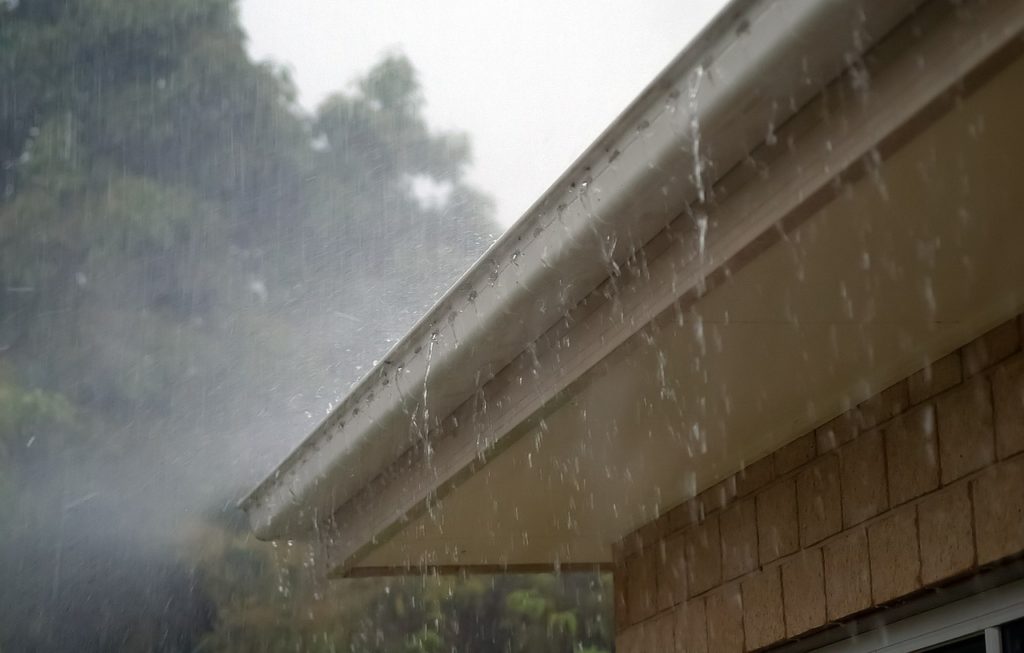Rain gutters play a vital role, being responsible for collecting water and then directing it away from your building. However, when gutters are not functioning properly, due to clogging or cracking, water can seep into the ground adjacent to your building’s foundation, resulting in structural damage and water leakage through walls. Left unchecked, mold can form, leading to allergies and respiratory infections.
The good news is that you can completely avoid the high costs of recovery from water damage by applying these tips.
 The Relationship Between Your Roof and Rain Gutters
The Relationship Between Your Roof and Rain Gutters
Rain gutters that are properly maintained are able to remove water from your roof the instant it rains. If gutters are not in optimal working order, this will cause water to collect on any areas of your roof that are low or flat. Over time, this standing water will damage your roof’s shingles and allow water to seep through your roof and into your building.
Ensure Your Gutters Are Clear
Although regular cleaning of your gutters may not be the most desirable task, it is a necessary one to ensure that they can continue to do their job. You should check your gutters on a regular basis to ensure they are free of debris.
One way to tell how effective your gutters are at redirecting water is to observe them during a heavy rainstorm. Doing so will quickly reveal areas where water may be escaping between gutters and the edges of your roof installation, as well as where water is overflowing your gutters due to possible clogging.
Look for Trees
Another thing to note are any trees which may be located near to your building. Trees that are close by will contribute significantly to gutter-clogging debris. As such, buildings surrounded by trees should have their gutters inspected and cleared on a more frequent basis, especially following periods of heavy rainfall and severe weather.
Don’t Forget the Downspouts
The gutters on your building will only be as good as the downspouts that are installed. Without downspouts that are free of debris and in good condition, rainwater can remain in your gutters, as well as leak out and down the sides of your building, creating unsightly water stains and major damage to its exterior.
Your building’s downspouts should be inspected for any debris that may be preventing the free flow of water. You should also ensure that all downspouts are directing water far enough away from the foundation of your building. Each downspout needs to have a minimum six-foot extension from your building so that water can be carried a sufficient distance away.
Check Gutter Rivets
All gutters should be sitting flush with your roof’s edges so that no water is flowing directly down into the ground adjacent to your foundation. If your gutters are not sitting properly, their rivets may have rusted and broken off. This is an easy problem for NJ commercial roofing professionals to fix, as rivets can be replaced quickly with a rivet gun.
 Other Things to Watch For
Other Things to Watch For
You’ll also want to ensure that your gutters themselves are not rusting, which will require closer inspection. Depending on the severity of rust, it may be able to be sanded away. However, if left unattended over time, your gutters will soon form the cracks and holes that allow water leakage.
Although no water may be escaping from your building’s gutters as yet, tiny cracks or splits can get larger with continued water flow and lead to major issues. Again, a roofing repair specialist can easily address cracks and splits with roofing cement or tape.
Ensuring that your gutters and downspouts are in good repair, free of debris and in good working order can save you thousands of dollars in repair and replacement costs.

 The Relationship Between Your Roof and Rain Gutters
The Relationship Between Your Roof and Rain Gutters Other Things to Watch For
Other Things to Watch For